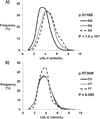Common low-density lipoprotein receptor p.G116S variant has a large effect on plasma low-density lipoprotein cholesterol in circumpolar inuit populations
- PMID: 25414273
- PMCID: PMC4560235
- DOI: 10.1161/CIRCGENETICS.114.000646
Common low-density lipoprotein receptor p.G116S variant has a large effect on plasma low-density lipoprotein cholesterol in circumpolar inuit populations
Abstract
Background: Inuit are considered to be vulnerable to cardiovascular disease because their lifestyles are becoming more Westernized. During sequence analysis of Inuit individuals at extremes of lipid traits, we identified 2 nonsynonymous variants in low-density lipoprotein receptor (LDLR), namely p.G116S and p.R730W.
Methods and results: Genotyping these variants in 3324 Inuit from Alaska, Canada, and Greenland showed they were common, with allele frequencies 10% to 15%. Only p.G116S was associated with dyslipidemia: the increase in LDL cholesterol was 0.54 mmol/L (20.9 mg/dL) per allele (P=5.6×10(-49)), which was >3× larger than the largest effect sizes seen with other common variants in other populations. Carriers of p.G116S had a 3.02-fold increased risk of hypercholesterolemia (95% confidence interval, 2.34-3.90; P=1.7×10(-17)), but did not have classical familial hypercholesterolemia. In vitro, p.G116S showed 60% reduced ligand-binding activity compared with wild-type receptor. In contrast, p.R730W was associated with neither LDL cholesterol level nor altered in vitro activity.
Conclusions: LDLR p.G116S is thus unique: a common dysfunctional variant in Inuit whose large effect on LDL cholesterol may have public health implications.
Keywords: cardiovascular diseases; genetic variation; low-density lipoprotein cholesterol.
© 2014 American Heart Association, Inc.
Figures



Similar articles
-
Lipoprotein profile of a Greenland Inuit population. Influence of anthropometric variables, Apo E and A4 polymorphism, and lifestyle.Arterioscler Thromb. 1992 Dec;12(12):1371-9. doi: 10.1161/01.atv.12.12.1371. Arterioscler Thromb. 1992. PMID: 1450169
-
The apolipoprotein E polymorphism in Greenland Inuit in its global perspective.Hum Genet. 1996 Nov;98(5):546-50. doi: 10.1007/s004390050257. Hum Genet. 1996. PMID: 8882873
-
Association between PON1 L/M55 polymorphism and plasma lipoproteins in two Canadian aboriginal populations.Clin Chem Lab Med. 2000 May;38(5):413-20. doi: 10.1515/CCLM.2000.060. Clin Chem Lab Med. 2000. PMID: 10952224
-
Genetic testing for familial hypercholesterolemia: Impact on diagnosis, treatment and cardiovascular risk.Eur J Prev Cardiol. 2019 Aug;26(12):1262-1270. doi: 10.1177/2047487319829746. Epub 2019 Feb 12. Eur J Prev Cardiol. 2019. PMID: 30755017
-
Clinical and pathophysiological evidence supporting the safety of extremely low LDL levels-The zero-LDL hypothesis.J Clin Lipidol. 2018 Mar-Apr;12(2):292-299.e3. doi: 10.1016/j.jacl.2017.12.018. Epub 2018 Jan 8. J Clin Lipidol. 2018. PMID: 29398429 Review.
Cited by
-
An LDLR missense variant poses high risk of familial hypercholesterolemia in 30% of Greenlanders and offers potential of early cardiovascular disease intervention.HGG Adv. 2022 Jun 9;3(4):100118. doi: 10.1016/j.xhgg.2022.100118. eCollection 2022 Oct 13. HGG Adv. 2022. PMID: 36267056 Free PMC article.
-
Genetics of Lipid and Lipoprotein Disorders and Traits.Curr Genet Med Rep. 2016;4(3):130-141. doi: 10.1007/s40142-016-0097-y. Epub 2016 Jun 7. Curr Genet Med Rep. 2016. PMID: 28286704 Free PMC article. Review.
-
Heart disease among Greenlandic children and young adults: a nationwide cohort study.Int J Epidemiol. 2022 Oct 13;51(5):1568-1580. doi: 10.1093/ije/dyac024. Int J Epidemiol. 2022. PMID: 35201265 Free PMC article.
-
Genetic architecture in Greenland is shaped by demography, structure and selection.Nature. 2025 Mar;639(8054):404-410. doi: 10.1038/s41586-024-08516-4. Epub 2025 Feb 12. Nature. 2025. PMID: 39939757 Free PMC article.
-
Striving Towards Equity in Cardiovascular Genomics Research.Curr Atheroscler Rep. 2025 Feb 18;27(1):34. doi: 10.1007/s11883-025-01277-z. Curr Atheroscler Rep. 2025. PMID: 39964583 Free PMC article. Review.
References
-
- Bjerregaard P, Dyerberg J. Mortality from ischaemic heart disease and cerebrovascular disease. Greenland Int J Epidemiol. 1988;17:514–519. - PubMed
-
- Bjerregaard P, Young TK, Hegele RA. Low incidence of cardiovascular disease among the Inuit--what is the evidence? Atherosclerosis. 2003;166:351–357. - PubMed
-
- Bjerregaard P, Mulvad G, Pedersen HS. Cardiovascular risk factors in Inuit of Greenland. Int J Epidemiol. 1997;26:1182–1190. - PubMed
Publication types
MeSH terms
Substances
Grants and funding
LinkOut - more resources
Full Text Sources
Medical

